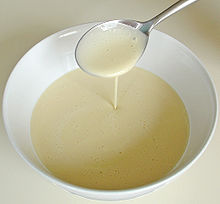Batter (cooking): Difference between revisions
in the preparation of foods |
|||
| Line 9: | Line 9: | ||
{{quote box|width=22em|Watching a woman make Russian pancakes, you might think that she was calling on the spirits or extracting from the batter the philosopher’s stone.|[[Anton Pavlovich Chekhov]]<ref>{{cite web|url=http://www.bartleby.com/66/14/11814.html |title=Bartleby.com |publisher=Bartleby.com |date= |accessdate=2009-03-16}}</ref>}} |
{{quote box|width=22em|Watching a woman make Russian pancakes, you might think that she was calling on the spirits or extracting from the batter the philosopher’s stone.|[[Anton Pavlovich Chekhov]]<ref>{{cite web|url=http://www.bartleby.com/66/14/11814.html |title=Bartleby.com |publisher=Bartleby.com |date= |accessdate=2009-03-16}}</ref>}} |
||
Batters may be used to make [[cakes]], [[pancakes]], [[crepe]]s, [[dosa]]s, [[appams]], [[idli]]s, [[vada]]s, [[Yorkshire pudding]], [[fritter]]s, [[Donut|doughnuts]], [[Hushpuppy|hushpuppies]], [[tempura]], some breads, to coat meat or vegetables when frying, or to make pancake, waffles or cookies. |
Batters may be used to make [[cakes]], [[pancakes]], [[crepe]]s, [[dosa]]s, [[appams]], [[idli]]s, [[vada]]s, [[Yorkshire pudding]], [[fritter]]s, [[Donut|doughnuts]], [[Hushpuppy|hushpuppies]], [[tempura]], [[blinz]] some breads, to coat meat or vegetables when frying, or to make pancake, waffles or cookies. |
||
Batter is used in some parts of the world to coat fish before frying. Batter makes up a critical component of the British dish [[fish and chips]] for instance. |
Batter is used in some parts of the world to coat fish before frying. Batter makes up a critical component of the British dish [[fish and chips]] for instance. |
||
Revision as of 16:30, 8 March 2010

Batter is a semi-liquid mixture of one or more flours combined with liquids such as water, milk or eggs used to prepare various foods. Often a leavening agent such as baking powder is included to aerate and fluff up the batter as it cooks, or the mixture may be naturally fermented for this purpose as well as to add flavour. Carbonated water or another carbonated liquid such as beer may instead be used to aerate the batter in some recipes.
The viscosity of batter may range from very "stiff" (adhering to an upturned spoon) to "thin" (similar to single cream, enough to pour or drop from a spoon and sometimes called "drop batter"). Heat is applied to the batter, usually by frying, baking or steaming, in order to cook the ingredients and to "set" the batter into a solid form. Batters may be sweet or savoury, often with either sugar or salt being added (sometimes both). Many other flavourings such as herbs, spices, fruits and vegetables may be added to the mixture.
The word batter comes from the old French word battre which means to beat [1], as many batters require vigorous beating or whisking in their preparation.
Usage
Watching a woman make Russian pancakes, you might think that she was calling on the spirits or extracting from the batter the philosopher’s stone.
Batters may be used to make cakes, pancakes, crepes, dosas, appams, idlis, vadas, Yorkshire pudding, fritters, doughnuts, hushpuppies, tempura, blinz some breads, to coat meat or vegetables when frying, or to make pancake, waffles or cookies.
Batter is used in some parts of the world to coat fish before frying. Batter makes up a critical component of the British dish fish and chips for instance.
Beer can be used to batter foods. Often, the purpose of battering foods with beer is for the bubbles in the beer to make the batter lighter. The concept of beer battering is popular in America, Europe, Russia, and the Middle-East. When foods are beer battered and fried (fish, chips, onion rings), the heat generated by the frying process evaporates most of the alcohol.[3][4]
See also
References
- ^ www.askoxford.com. "AskOxford.com". AskOxford.com. Retrieved 2009-03-16.
- ^ "Bartleby.com". Bartleby.com. Retrieved 2009-03-16.
- ^ "http://www.betterendings.org/Recipes/cookal.htm". Betterendings.org. Retrieved 2009-03-16.
{{cite web}}: External link in|title= - ^ Augustin J, Augustin E, Cutrufelli RL, Hagen SR, Teitzel C (1992). "Alcohol Retention in Food Preparation". Journal of the American Dietetic Association. 92 (4): 486–8. PMID 1556354.
{{cite journal}}: CS1 maint: multiple names: authors list (link)
